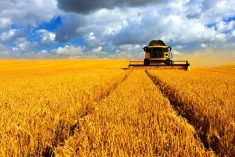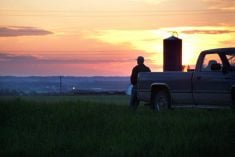GUIDEPOSTS
Agriculture reigns in Taber and everybody knows it the minute they hit the town limits.
Driving in from the west, you pass the usual restaurants and gas stations, but mostly you notice the farm equipment dealers and agri-businesses standing shoulder to shoulder along Highway 3. Or if you make the trip in from the east, you see Rogers Sugar in all its blue and white glory rising above a host of other agri-food processors, including Frito-Lay.
Then the farm links continue right into the heart of town. In fact, most of the houses in the new subdivisions are agricultural too, even if there aren’t any pickups parked out front, and most of the businesses owe their success to their farm clientele.
Read Also

Producers aren’t panicking over tariffs and trade threats
The influence of tariff and trade uncertainity on farm business decisions.
This is a town that knows what side its bread is buttered on, and because it does, it’s actually helping to fuel the surge in the region’s farm outlook.
Tabre and its 8,000 residents are a long way from Alberta’s tech, tourist and commercial industries. But they do have one thing going for them.
There are a million acres in the municipal district surrounding the town in the south central part of the province, 45 minutes east of Lethbridge and an hour north of the Montana border. And it’s quite a million acres, with about a third in native grassland and another third dryland farmed with durum and hard red spring wheat, plus 151,000 head of cattle under cow-calf production and 110,000 hogs.
Then there’s roughly a third of the district’s acres that are irrigated, growing a long list of crops from sugar beets and sweet corn to peas and lentils, including a big chunk of the province’s 50,000-acre potato crop.
“When you look at the total production of the municipal district’s 768 farms, with gross farm receipts of $500,000 million, the intensity of agriculture is quite significant,” says Derrick Krizsan, administrator of the Municipal District of Taber and its 6,700 people. “The intensity is what’s impressive about this area.”
It’s a two-way street. Intensive production of specialty crops has led to job-intensive agri-food processing in the town.
To grow, the town of Taber needs high-value farming. Equally, farmers in the area need the processors and services in the town.
Of course, as everyone in the area knows, there’s a third leg to this stool.
“It’s water that makes the area so productive,”
How Taber got its name
It’s still hotly contested, but here are the two leading theories.
According to Alberta Place Names, Taber was named for the first part of the word, “tabernacle,” in consideration for Mormon settlers. Judge J. A. Jackson of Lethbridge, however, says the name derives from the Biblical “Mount Tabor.” He submitted evidence that “Tabor” was on two town plans registered in March 1906, but later the spelling was changed to “Taber” and used consistently thereafter.
says Greg Sekura, talking into his cell phone while spraying fields about five miles southeast of the town. “Also, our hot days and cool nights help crop growth, as we have enough heat units for many types of crops and the cool nights reduce the spread of disease.”
“The economic spinoffs that irrigation provides to the Taber area are insurmountable,” says Sekura, who has been a councillor with the MD of Taber for the past nine years.
Sekura, who was born in the area and whose family has been farming there for three generations, acknowleges the benefits of a strong Taber too. As a sugar beet grower, Sekura says his transportation costs are reduced, as the Rogers factory is so close for beet delivery. It’s also efficient to be so close to the town to pick up parts or chemicals or other agricultural products for the irrigated durum and hard wheat that he grows, just as it for the neighbours that he rents land to for potato and onion production.
He foresees water as one challenge for the future, even though irrigation technologies are constantly improving. “We’re already up against the wall to become even more efficient with our water use.”
With so much riding on water, there are major efforts underway to get every pound of high-value crop from every gallon. Krizsan gives credit to the innovation and management of the three irrigation districts within the MD of Taber: Taber, St. Mary River and Bow River.
As there are no new water licenses allowed in the South Saskatchewan River Basin, irrigation districts are finding ways to use and move water more efficiently, such as using closed pipes rather than canals.
Meanwhile, the municipal district has laid out a roadmap to 2020 that is based on agriculture, food processing, light industrial development, “green” energy and the oil and gas industry. Its new sustainability plan focuses on economic sustainability, the environment, municipal infrastructure, and attracting a sustainable population growth, as people are essential to maintaining the economy.
“We’re open for business,” says Krizsan, pointing to the area’s favourable tax rate and regulatory regime.
Irrigation History
Taber’s irrigation history can be traced back to 1885, when the Canadian Pacific Railway built Tank 77 along the tracks through what was to become Taber.
At that time, the Alberta Rail and Coal Co. was laying the tracks for the CPR. They were paid partly in cash and partly in land. C. A. Magrath was the land commissioner for the company and realized that if they were going to sell this land for a good price it would need to be irrigated.
Magrath put in a call to the Church of Latter Day Saints in Utah, offering 30,000 acres of land at a cost of $1 per acre if Mormons would come to Alberta and build an irrigation system. He knew that they had irrigation experience in Utah.
The Mormons didn’t have the money but they made a counteroffer to build the canal under contract for $3 per day for a man and a team of horses, paid half in cash and half in land.
Pioneering families from Utah answered the call and began the trek to southern Alberta. The project began in August 1898.
Shovels, plows and scrapers pulled by horses dug a 100-mile canal, known as the “Big Ditch”, almost to Lethbridge from the headwaters at Kimball, south of Cardston.
By 1907, Taber had reached the size to become a town and farmers in the area realized that it was time to push the existing irrigation further east from Lethbridge.
Slowly the system was expanded east from Lethbridge through Coaldale and eventually to Barnwell, just a few kilometres west of Taber, in 1909. This led to the much larger Taber Irrigation District and the development of today’s extensive irrigation system in the MD of Taber.
Source:TaberIrrigationImpa ct Museum
The town of Taber also welcomes new development, according to Chamber of Commerce President Louie Tams. The local business owner knows that agriculture is a big part of what’s put Taber on the map.
“As we say, all roads lead to Taber,” says Tams, sitting in his office at Horizon Implements, a farm
equipment dealer. “It’s a good place to earn a living and to raise a family.”
Tams says that agriculture lends stability to the area during economic highs and lows, even though the industry itself goes through cycles.
A tour of Taber’s industrial area shows the impact of agriculture on the town — every second business has some direct agricultural connection.
The chamber of commerce in Taber is one of the few chambers in Canada with an agriculture committee. It consists of chamber members, with representatives from various agricultural industry groups, such sugar beets and potatoes.
“We are a voice for all business and that includes agri-business and farm businesses,” says Tams. “Even though the economic climate is slow right now, and everyone is tightening their belts, I have no doubt that Taber will continue to grow. It might take six months or more but we will bounce back and survive.”
Not too long ago, there were more jobs than houses available in town, says John Henricks, planning and economic development director with the Town of Taber. Now there are several new residential subdivisions, a testament to a growing town.
“So many people were commuting from outside of town for work,” Henricks says. Yet the town wasn’t growing. “We needed new residential areas to promote growth.”
When Henricks came on board about four years ago, he noticed that Taber was in desperate need of an update to its land use (zoning) bylaw, which was last amended in 1987.
Even today, though, Taber doesn’t have a specific growth strategy. Any development falls under the municipal development plan, last updated in 1998. While this plan provides some guidance for area development, it doesn’t specifically direct the town’s growth.
It’s been on Henricks’ agenda to update the municipal plan but that will fall into the hands of his successor, as Henricks moves to Medicine Hat for another town planning position this summer.
The biggest changes in Taber in the past five years, though, have been new subdivisions in the west, the opening up of residential space downtown and increased acres for industrial development in the northeast.
Armed with a new sustainability plan, called “Simple As Dirt,” the town is aiming to be sustainable for the long term. One small aspect of the plan is solar panels installed on the town’s welcome sign to fuel the display lights.
“All agri-food processors were fighting to find labour, and that’s why housing is critical,” says Henricks. “I think food processors can start to look at expansion now that there is more housing available in Taber.”
Frito-Lay is already making investments in its Taber facility, with a 10,000-square-foot expansion. While the addition might not create many new jobs, it will keep jobs in the community.
“Taber is going to need to expand its boundar-
Irrigation History
Taber’s irrigation history can be traced back to 1885, when the Canadian Pacific Railway built Tank 77 along the tracks through what was to become Taber.
At that time, the Alberta Rail and Coal Co. was laying the tracks for the CPR. They were paid partly in cash and partly in land. C. A. Magrath was the land commissioner for the company and realized that if they were going to sell this land for a good price it would need to be irrigated.
Magrath put in a call to the Church of Latter Day Saints in Utah, offering 30,000 acres of land at a cost of $1 per acre if Mormons would come to Alberta and build an irrigation system. He knew that they had irrigation experience in Utah.
The Mormons didn’t have the money but they made a counteroffer to build the canal under contract for $3 per day for a man and a team of horses, paid half in cash and half in land.
Pioneering families from Utah answered the call and began the trek to southern Alberta. The project began in August 1898.
Shovels, plows and scrapers pulled by horses dug a 100-mile canal, known as the “Big Ditch”, almost to Lethbridge from the headwaters at Kimball, south of Cardston.
By 1907, Taber had reached the size to become a town and farmers in the area realized that it was time to push the existing irrigation further east from Lethbridge.
Slowly the system was expanded east from Lethbridge through Coaldale and eventually to Barnwell, just a few kilometres west of Taber, in 1909. This led to the much larger Taber Irrigation District and the development of today’s extensive irrigation system in the MD of Taber.
Source:TaberIrrigationImpa ct Museum
The town of Taber also welcomes new development, according to Chamber of Commerce President Louie Tams. The local business owner knows that agriculture is a big part of what’s put Taber on the map.
“As we say, all roads lead to Taber,” says Tams, sitting in his office at Horizon Implements, a farm
equipment dealer. “It’s a good place to earn a living and to raise a family.”
Tams says that agriculture lends stability to the area during economic highs and lows, even though the industry itself goes through cycles.
A tour of Taber’s industrial area shows the impact of agriculture on the town — every second business has some direct agricultural connection.
The chamber of commerce in Taber is one of the few chambers in Canada with an agriculture committee. It consists of chamber members, with representatives from various agricultural industry groups, such sugar beets and potatoes.
“We are a voice for all business and that includes agri-business and farm businesses,” says Tams. “Even though the economic climate is slow right now, and everyone is tightening their belts, I have no doubt that Taber will continue to grow. It might take six months or more but we will bounce back and survive.”
Not too long ago, there were more jobs than houses available in town, says John Henricks, planning and economic development director with the Town of Taber. Now there are several new residential subdivisions, a testament to a growing town.
“So many people were commuting from outside of town for work,” Henricks says. Yet the town wasn’t growing. “We needed new residential areas to promote growth.”
When Henricks came on board about four years ago, he noticed that Taber was in desperate need of an update to its land use (zoning) bylaw, which was last amended in 1987.
Even today, though, Taber doesn’t have a specific growth strategy. Any development falls under the municipal development plan, last updated in 1998. While this plan provides some guidance for area development, it doesn’t specifically direct the town’s growth.
It’s been on Henricks’ agenda to update the municipal plan but that will fall into the hands of his successor, as Henricks moves to Medicine Hat for another town planning position this summer.
The biggest changes in Taber in the past five years, though, have been new subdivisions in the west, the opening up of residential space downtown and increased acres for industrial development in the northeast.
Armed with a new sustainability plan, called “Simple As Dirt,” the town is aiming to be sustainable for the long term. One small aspect of the plan is solar panels installed on the town’s welcome sign to fuel the display lights.
“All agri-food processors were fighting to find labour, and that’s why housing is critical,” says Henricks. “I think food processors can start to look at expansion now that there is more housing available in Taber.”
Frito-Lay is already making investments in its Taber facility, with a 10,000-square-foot expansion. While the addition might not create many new jobs, it will keep jobs in the community.
“Taber is going to need to expand its boundar-
ies,” says Henricks. A preliminary annexation study gives the town a general idea of where it can grow. “Most residential will have to go south, and most industrial will have to go north.”
Whether new agri-businesses locate in Taber or the Municipal District of Taber, the town will always be the service centre to about 25,000 people.
There is also more industrial land available for development under the new land use bylaw. Henricks says the town recently sold an acre and has commitments on three other acres. It also has the flexibility to add another 10 to 15 acres of industrial area.
One event that always draws thousands of people into town is CornFest. This year’s event is August 27 to 30, with many of the same activities that make it so popular, including the chili cook-off, corn-eating contest and fireworks.
Tom Paterson, chair of CornFest’s organizing committee, says the event capitalizes on Taber’s reputation for sweet corn and coincides with harvest. Tams, co-chair, calls CornFest the “last free party in Western Canada.”
The event was started more than 20 years ago as a Chamber of Commerce initiative to bring people into town during a time when street repaving and upgrades to sewer and water lines were affecting local business.
Sustainability seems to be the key word as both the Town of Taber and the MD of Taber move forward. And no industry knows sustainability better than agriculture.
“Agriculture is big part of Taber’s growth,” says Henricks. “People need to eat and none of it would be possible without irrigation.” CG
ies,” says Henricks. A preliminary annexation study gives the town a general idea of where it can grow. “Most residential will have to go south, and most industrial will have to go north.”
Whether new agri-businesses locate in Taber or the Municipal District of Taber, the town will always be the service centre to about 25,000 people.
There is also more industrial land available for development under the new land use bylaw. Henricks says the town recently sold an acre and has commitments on three other acres. It also has the flexibility to add another 10 to 15 acres of industrial area.
One event that always draws thousands of people into town is CornFest. This year’s event is August 27 to 30, with many of the same activities that make it so popular, including the chili cook-off, corn-eating contest and fireworks.
Tom Paterson, chair of CornFest’s organizing committee, says the event capitalizes on Taber’s reputation for sweet corn and coincides with harvest. Tams, co-chair, calls CornFest the “last free party in Western Canada.”
The event was started more than 20 years ago as a Chamber of Commerce initiative to bring people into town during a time when street repaving and upgrades to sewer and water lines were affecting local business.
Sustainability seems to be the key word as both the Town of Taber and the MD of Taber move forward. And no industry knows sustainability better than agriculture.
“Agriculture is big part of Taber’s growth,” says Henricks. “People need to eat and none of it would be possible without irrigation.” CG














